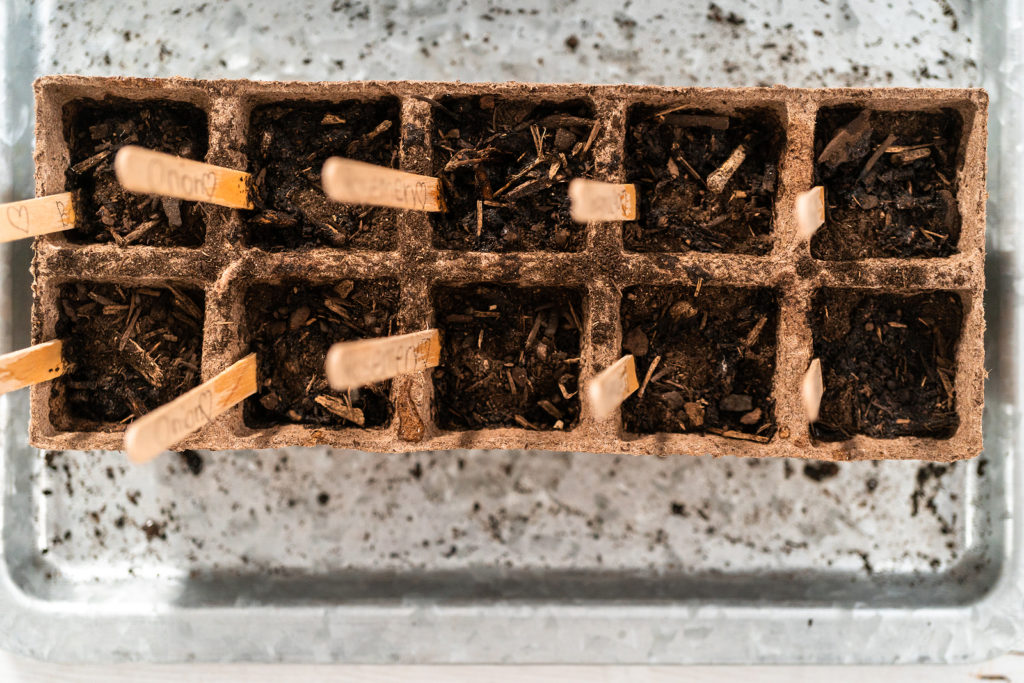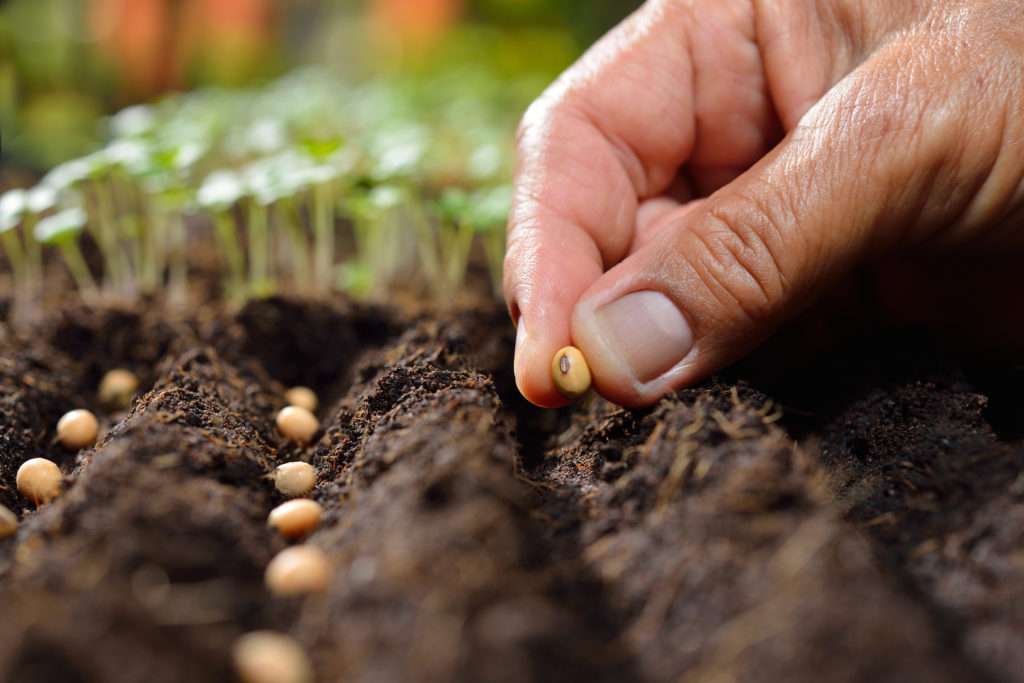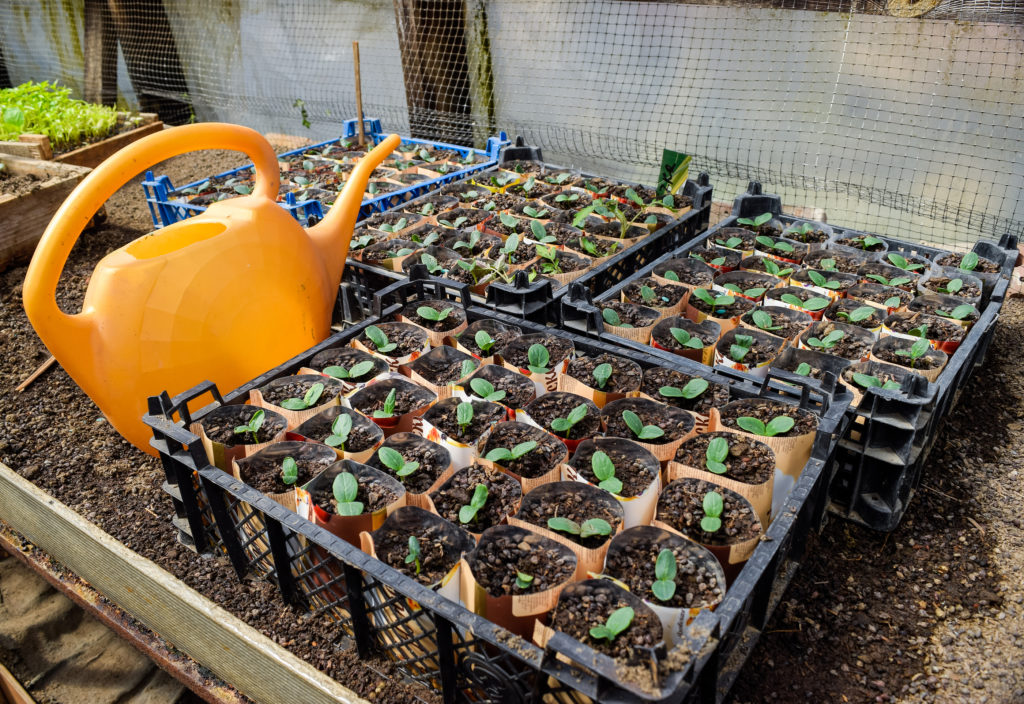Here are seed starting tips–both indoors and outdoors–and the schedule for April zone-by-zone. If you are unfamiliar with the USDA zone where you live, look at the minimum annual temperature guideline following each zone.
Soil and Seed Starting Mix
Getting seed started indoors is essentially the same as sowing seed outdoors directly in the garden. If you are starting seed indoors be sure to use a medium or seed-starting mix that is sterile. Soil or seed starting medium should be slightly damp, but not wet when the seeds are sown. You can make your own seed-starting mix by combining sand and peat, half-and-half.

Seed Starting
Instead of using clear water, you can speed up germination by watering in new seeds with a dilute solution of manure or compost tea. If you sow seed indoors in paper or peat pots that can be set directly in the garden, seedlings will withstand the shock of final transplanting to the open garden much better, simply because there will be less injury to the root system than if taken up by the root ball from the starting tray. If you are potting up seedlings from trays to pots, do it as soon as the first true leaves develop.
Good Products at Amazon for Seed Starting Success:
- Jump Start Germination Station w/Heat Mat Tray, 72-Cell Pack, Dome
- Espoma Seed Starting Mix
- 200 Count- Jiffy 7 Peat Soil Seed Starting Plugs
- Seed Starter Kit with Humidity Dome (120 Cells Total Tray)
- AgrobriteT5 Fluorescent, 2-Foot, Grow Light System
Transplanting
When it’s time to transplant a seedling to the open garden–whether you started the seedlings yourself or bought them at the garden center, make sure the soil in the garden has been prepared in advance. Dig the holes, properly spaced, before you begin transplanting. Set plants in the ground no deeper than they were in the hotbed or cold frame. If the seedlings are in paper or peat pots, set them even with the soil of their former containers; this will help prevent stem rot which sometimes comes with banking soil too high around plants.
Water in newly transplanted crops and then shade them from the sun and wind until they are established.
Direct Sowing Seed
If you are direct sowing outdoors, scatter seed evenly in shallow trenches, then cover the seeds by raking fine soil over them to the recommended depth, and firm the seed in with the back of the rake. Seeds must make close contact with the soil to germinate. Generally, seeds should be sown to a depth from two to four times their diameter.
If you are starting seeds in the garden during a dry spell, germination and growth will be sped up if you first fill the trench or seed row with water. As soon as the water has seeped into the soil, you can sow your seed and cover them with loose dry soil.

Seed Lists for April Sowing
Cool northern regions—Zones 3-6. Vegetables: artichoke suckers, beans, beets, Brussels sprouts, cabbage, cape gooseberry, capsicum, carrots, celery, chard (silverbeet), cress, cucumber, eggplant, endive, kohlrabi, leeks, lettuce, marrow, melons, okra, spring onion, parsnip, peas, potato tubers, radish, rhubarb crowns, rutabaga (Swedes), salsify, Swiss chard (silverbeet), spinach, squash, sweet corn, tomato, zucchini. Herbs: basil, borage, caraway, celeriac, chamomile, chervil, chives, coriander, hyssop, lemon balm, oregano, parsley, salad burnet, thyme.
Temperate Regions—Zones 7-9. Vegetables: beans, beets (beetroot), cabbage, cape gooseberry, capsicum, carrots, celery, chard (silverbeet), chayote (choko), chicory, cress, cucumber, eggplant, endive, leeks, lettuce, melons, mustard, spring onions, parsnip, peas, pumpkin, radish, rhubarb crowns, salsify, squash, sweet corn, sweet potato, tomato, zucchini. Herbs: basil, borage, caraway, celeriac, chamomile, chervil, chicory, chili, chives, coriander, dill, fennel, hyssop, lemon balm, oregano, parsley, salad burnet, thyme.
Subtropical and Tropical Regions—Zones 10-12. Vegetables: beans, beet (beetroot), cabbage, cape gooseberry, capsicum, carrots, celery, chayote (choko), Chinese cabbage, cress, cucumber, eggplant, fennel, lettuce, marrow, melons, mustard, okra, parsnip, peas, pumpkin, radish, rhubarb crowns, salsify, Swiss chard (silverbeet), spring onion, squash, strawberry runners, sweet corn, sweet potato, tomato, zucchini. Herbs: basil, borage, caraway, chamomile, celeriac, chervil, coriander, dill, hyssop, lemon balm, marjoram, oregano, salad burnet, thyme.
Zone-by-Zone Seed Starting Guide for April
Listed by USDA Plant Hardiness Zones, warmest zones first:
Zone 10-11:
(Where the annual low temperatures can reach 30°F /-1°C.)
- Direct-sow or plant out tender vegetables and herbs.
- Plant sweet potatoes and okra now.
- Feed seedlings with liquid fertilizer after planting.
- Thin seedlings of earlier plantings.
- Plant tropical fruits.
- Remove bolted cabbage family crops and leafy greens from the garden and compost them.
- Plant lemongrass, Cuban oregano, and Vietnamese coriander as parsley, coriander, and dill go to seed;
Zone 9:
(Where the annual low temperatures can reach 20°F /-7°C.)
- Begin replacing spent cool-weather crops.
- Start sowing warm-weather vegetables without protection once the last frost is past; check seed packets if you are not sure when seeds can go in the garden.
- Sow cantaloupe, pumpkins, and squash late in the month.
- Plant now okra, asparagus beans, Malabar spinach, cherry tomatoes, and sunflowers.
- Plant and cage tomatoes, peppers, and eggplant.
- Indoors continue to sow tomatoes, runner beans, and cucumbers.
- Feed seedlings with liquid fertilizer after planting.
- Thin out overcrowded vegetable seedlings.
- Use horticultural fleece or floating cloches if you suspect another frost.
- Side-dress rows of garlic, shallots, and onions with aged compost.
- Thin heavy-cropping nectarines and peaches when the fruit is ½ in (1-1.5 cm) in diameter.
- Plant tropical fruits.
Zone 8:
(Where the annual low temperatures can reach 10°F /-12°C.)
- Thin out overcrowded vegetable seedlings.
- Direct-sow or plant out successions of cool-weather vegetables and herbs where the temperatures will remain moderate, 75°F (24°C) or less.
- Continue to plant onion sets in the north.
- Plant early potatoes.
- Plant out summer cabbages started indoors last month.
- Sow purple-spouting broccoli, winter cabbages, and late-summer cauliflowers in a nursery bed.
- Plant asparagus crowns.
- Begin to replace fading cool-weather crops with warm-weather crops when the danger of frost is past.
- Prepare to set out tomatoes, peppers, and eggplant toward the end of the month.
- Sow sweet corn, squash, cucumbers, and beans at the end of the month.
- Start sweet potato slips to transplant next month.
- Feed seedlings with liquid fertilizer after planting.
- Thin seedlings of earlier plantings.
- Water garden if weather is dry. Weed as needed.
- Herbs: plant out sweet bay, hyssop, lavender, mint, rosemary, rue, and sage. Make further sowings of dill, fennel, parsley, and pot marjoram. Sow basil indoors. Layer creeping stems of thyme to root new plants.
- Plant new strawberries. Put cloches over strawberries if you want an early corp.
- Remove rhubarb flowers as soon as they appear; this allows the plant to continue strong growth.
- Thin heavy-cropping nectarines and peaches when the fruit is ½ in (1-1.5 cm) in diameter; thin to 6 inches (15cm) apart.
Good Products at Amazon for Raised Bed Growing
- Galvanized Raised Bed 8×3
- Cedar Raised Bed 4×8
- Elevated Cedar Planter 4×2
- Walk-In Greenhouse Tunnel 15x7x7
- Row Cover for Freeze Protection 10×30
Zone 7:
(Where the annual low temperatures can reach 0°F /-18°C.)
- Direct-sow or plant out successions of cold-tolerant vegetables and herbs: lettuce, turnips, runner beans, green beans, endive, carrots, radishes, kohlrabi, and Chinese cabbage.
- Plant potatoes.
- Sow seeds of late cabbages and cauliflowers in a nursery bed where they can be grown for later transplanting.
- Thin seedlings of earlier plantings.
- Early-ripening tomato cultivars can be set out under cloches at the end of the month.
- At month’s end if a late frost does not threaten, plant out vegetable seedlings such as cabbages, cauliflowers, celery, sweet corn, tomatoes, and squashes.
- When a late frost is unlikely, sow sweet corn, cucumbers, summer squash, bush beans, runner and pole beans, and warm-season herbs.
- Stop picking asparagus so that the plants do not exhaust themselves.
- Set strawberries and blackberries: tie new canes of blackberries and hybrid berries to a system of support wires, allowing a maximum of eight canes per plant.
Zone 6:
(Where the annual low temperatures can reach –10°F /-23°C.)
- Prepare planting beds. Apply aged compost and manure, and fertilizers as needed.
- Prepare runner bean and celery trenches.
- Place cloches and plastic tunnels in a position to warm up the soil.
- Sow early cool-weather crops in cold frames or beneath cloches.
- Sow broad beans under cloches.
- Start sowing vegetables without protection if you live in a mild area; check the seed packets to make sure they are suitable for early sowing.
- Direct-sow or plant out cold-tolerant vegetables and herbs.
- Make the first sowing of carrots.
- Sow early peas.
- Plant spinach, lettuce, and other leafy greens under cloches.
- Set out kohlrabi and broccoli under cloches.
- Sow onions, scallions, and shallots.
- Chit (sprout) ‘seed’ potatoes (small tubers) of early varieties.
- Force rhubarb.
- Remove flowers from newly planted strawberries.
- Plant new fruit trees.

Zone 5:
(Where the annual low temperatures can reach -20°F /-29°C.)
- Prepare planting beds. Apply aged compost and manure, and fertilizers as needed.
- Place cloches and black plastic sheeting in a position to warm up the soil. Use horticultural fleece or floating row covers for early crops if you don’t have conventional cloches.
- Sow early crops in cold frames or beneath cloches.
- Start sowing vegetables without protection if you live in a mild area; check seed packets to make sure they are suitable for early sowing.
- Harden off cabbages then set out plants under cloches
- Sow broad beans under cloches.
- Chit (sprout) ‘seed’ potatoes (small tubers) of early varieties.
- Plant early potatoes and onion sets.
- Plant peas then carrots, lettuce, spinach, and other greens in a sheltered location.
- Sow broad beans, cauliflower, Brussels sprouts, onions, radishes, and parsnips.
- Plant new asparagus and rhubarb
- Force rhubarb.
- Make the second sowing of early peas two weeks after the first sowing.
- Start basil, tomato, and pepper seedlings indoors.
- Put cloches over strawberries if you want an early cop. Plant new strawberries.
- Plant new fruit trees.
Zone 4:
(Where the annual low temperatures can reach -30°F /-34°C.)
- Prepare planting beds. Apply aged compost and manure, and fertilizers as needed.
- Place cloches and black plastic sheeting in a position to warm up the soil. Use horticultural fleece or floating row covers for early crops if you don’t have conventional cloches.
- Sow early crops in cold frames or beneath cloches.
- Place cloches in a position to warm up the soil.
- Plant out spring vegetables when heavy frost is past.
- Sow spinach, lettuce, and radishes then cover with plastic tunnels
- Harden off cabbage, broccoli, and cauliflower seedlings for a week before setting them out in the garden under cloches
- Sow broad beans under cloches.
- Late this month, plant potatoes and peas. Sow early peas in a sheltered spot.
- Sow onions, scallions, and shallots.
- Sow tomatoes, peppers, basil, and other warm-weather crops indoors,
- Force rhubarb.
- Chit (sprout) ‘seed’ potatoes (small tubers) of early varieties.
- Put cloches over strawberries if you want an early crop.
- Plant fruit trees, bushes, and brambles when the soil is workable.
Zone 3:
(Where the annual low temperatures can reach -40°F /-40°C.)
- Prepare the soil for early planting; cover the soil with black plastic for several sunny days before digging.
- Sow early crops in cold frames or beneath cloches.
- Sow broad beans under cloches.
- After the soil warms, begin planting onions, peas, spinach, carrots, lettuce, beets, chard, and radishes.
- When the weather permits, set out new asparagus and rhubarb plants.
- Sow onions, scallions, and shallots.
- Chit (sprout) ‘seed’ potatoes (small tubers) of early varieties.
- Late in the month, start tomatoes, peppers, and eggplants indoors.
- Force rhubarb.
- Set out new strawberries under cloches if you want an early crop.
- Plant new fruit trees.
Also of interest:
Vegetable Seed Germination Requirements
Garden Planning Books at Amazon:
- Vegetable Garden Almanac & Planner
- Kitchen Garden Grower’s Guide Vegetable Encyclopedia
- Vegetable Garden Grower’s Guide
- Tomato Grower’s Answer Book
Need complete seed starting info at your fingertips: THE KITCHEN GARDEN GROWERS’ GUIDE–click here.















